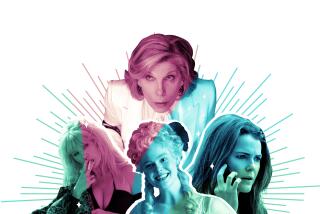Alpha Females Still Trail Adorable Dopes
A recent article by Judith Michaelson touted the prevalence of âalpha womenâ in the current prime-time season (âAlpha Women Act With Authority,â Nov. 27). Citing a few high-profile female characters appearing on dramas, the article suggested that powerful women are now in vogue. But Michaelson is only half right. While many of this seasonâs dramas feature a relatively new kind of working woman who integrates successful (if challenging) home and work lives, sitcom sisters do not enjoy a similar, well-written fate.
Perhaps the most prolific type of female character in the current season is the âadorable dope,â a term coined by producer Bonnie Turner to describe the dizzy girl-woman who represents an
updated, politically correct version of yesterdayâs bimbo. With hearts of gold and brains of mush, characters such as Grace (âWill & Graceâ), Dharma (âDharma & Gregâ) and Veronica (âVeronicaâs Closetâ) donât have a clue.
While Grace and Dharma are younger adorable dopes, Veronica should be old enough to know better. As one of the only
shows to feature a 40-plus woman in the title role, âVeronicaâs Closetâ offers a plethora of embarrassing portrayals, from Kirstie Alleyâs ever-youthanized Veronica to newcomer (and true bimbo) June. Veronica sports fluffy, childlike hairdos and lingerie-inspired clothing that no self-respecting female executive would ever wear outside the bedroom. Her indecision and compelling need to please others are curious personality traits for the chief executive of a multimillion-dollar lingerie company.
As a female viewer, I find the portrayal of women as adorable dopes perplexing and alienating. Whatâs so funny about dumb women? Unless, of course, the intended audience for these female-driven programs is actually young males who might feel intimidated by truly powerful women. Which brings us to the paradox of prime-time television. Although more women than men watch prime time each and every night of the week, male characters outnumber female characters nearly 2 to 1. Further, most female characters are clearly constructed to appeal to a male audience.
If, in fact, women view television to watch others like themselves (as research and common sense indicate), they have fewer choices than men. And for female viewers 40 and older, television is truly a vast wasteland, virtually devoid of images that reflect their age cohort. Fully 60% of all female characters in the 1998-99 season were in their 20s or 30s.
Michaelsonâs article posits that the portrayal of powerful females is cyclical--they are in one season and out the next. (Can you imagine a prime-time world in which strong male characters came and went?) Itâs not that weâve never seen strong females in situation comedies. Murphy Brown, Cybill and Grace (âGrace Under Fireâ) were all tremendously funny, smart and quick-witted. Why not use these characters as templates to create a new generation of females we can laugh with, not at?
Martha M. Lauzen, PhD, is a professor in the School of Communication at San Diego State University.
More to Read
The complete guide to home viewing
Get Screen Gab for everything about the TV shows and streaming movies everyoneâs talking about.
You may occasionally receive promotional content from the Los Angeles Times.






